SKODA ROOMSTER 2014 1.G Owner's Manual
Manufacturer: SKODA, Model Year: 2014, Model line: ROOMSTER, Model: SKODA ROOMSTER 2014 1.GPages: 204, PDF Size: 14.15 MB
Page 181 of 204
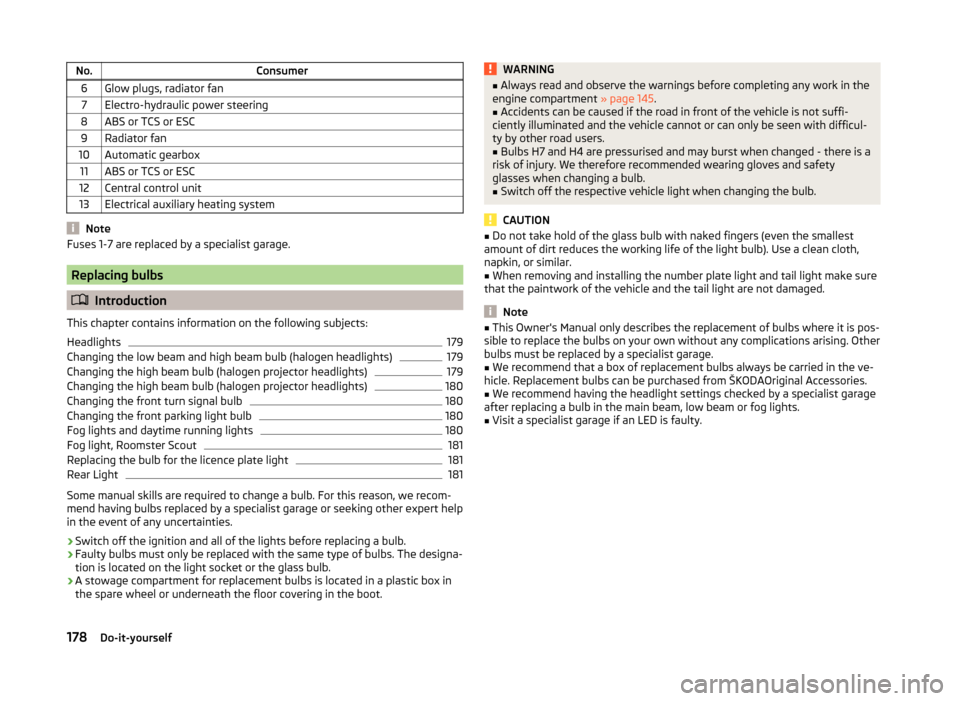
No.Consumer6Glow plugs, radiator fan7Electro-hydraulic power steering8ABS or TCS or ESC9Radiator fan10Automatic gearbox11ABS or TCS or ESC12Central control unit13Electrical auxiliary heating system
Note
Fuses 1-7 are replaced by a specialist garage.
Replacing bulbs
Introduction
This chapter contains information on the following subjects:
Headlights
179
Changing the low beam and high beam bulb (halogen headlights)
179
Changing the high beam bulb (halogen projector headlights)
179
Changing the high beam bulb (halogen projector headlights)
180
Changing the front turn signal bulb
180
Changing the front parking light bulb
180
Fog lights and daytime running lights
180
Fog light, Roomster Scout
181
Replacing the bulb for the licence plate light
181
Rear Light
181
Some manual skills are required to change a bulb. For this reason, we recom-
mend having bulbs replaced by a specialist garage or seeking other expert help
in the event of any uncertainties.
› Switch off the ignition and all of the lights before replacing a bulb.
› Faulty bulbs must only be replaced with the same type of bulbs. The designa-
tion is located on the light socket or the glass bulb.
› A stowage compartment for replacement bulbs is located in a plastic box in
the spare wheel or underneath the floor covering in the boot.
WARNING■ Always read and observe the warnings before completing any work in the
engine compartment » page 145.■
Accidents can be caused if the road in front of the vehicle is not suffi-
ciently illuminated and the vehicle cannot or can only be seen with difficul-
ty by other road users.
■
Bulbs H7 and H4 are pressurised and may burst when changed - there is a
risk of injury. We therefore recommended wearing gloves and safety
glasses when changing a bulb.
■
Switch off the respective vehicle light when changing the bulb.
CAUTION
■ Do not take hold of the glass bulb with naked fingers (even the smallest
amount of dirt reduces the working life of the light bulb). Use a clean cloth,
napkin, or similar.■
When removing and installing the number plate light and tail light make sure
that the paintwork of the vehicle and the tail light are not damaged.
Note
■ This Owner's Manual only describes the replacement of bulbs where it is pos-
sible to replace the bulbs on your own without any complications arising. Other
bulbs must be replaced by a specialist garage.■
We recommend that a box of replacement bulbs always be carried in the ve-
hicle. Replacement bulbs can be purchased from ŠKODAOriginal Accessories.
■
We recommend having the headlight settings checked by a specialist garage
after replacing a bulb in the main beam, low beam or fog lights.
■
Visit a specialist garage if an LED is faulty.
178Do-it-yourself
Page 182 of 204
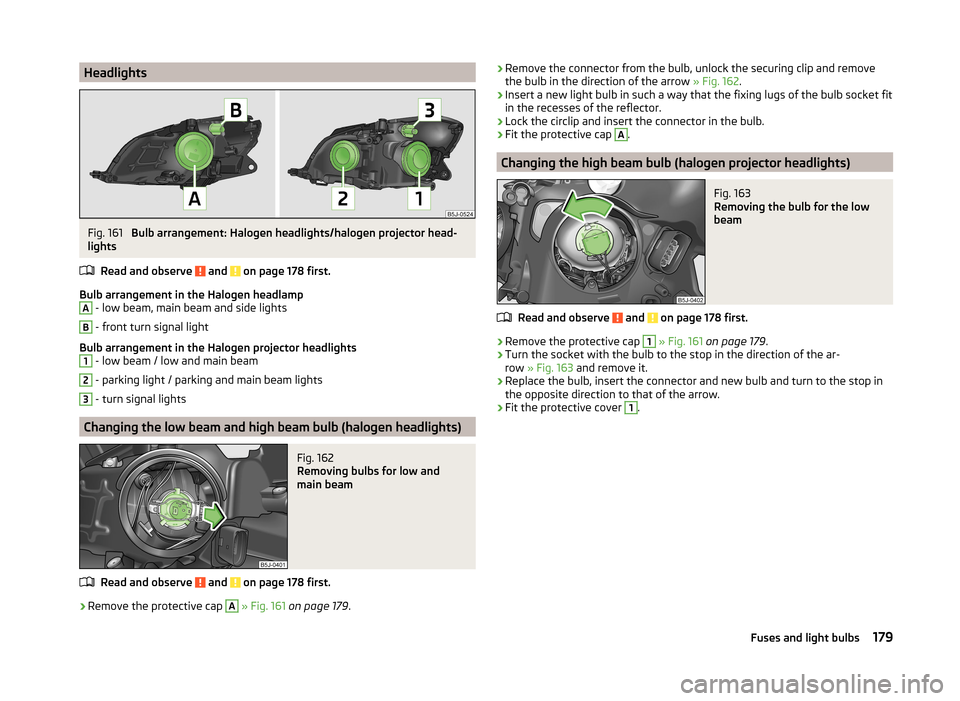
HeadlightsFig. 161
Bulb arrangement: Halogen headlights/halogen projector head-
lights
Read and observe
and on page 178 first.
Bulb arrangement in the Halogen headlamp
A
- low beam, main beam and side lights
B
- front turn signal light
Bulb arrangement in the Halogen projector headlights
1
- low beam / low and main beam
2
- parking light / parking and main beam lights
3
- turn signal lights
Changing the low beam and high beam bulb (halogen headlights)
Fig. 162
Removing bulbs for low and
main beam
Read and observe and on page 178 first.
›
Remove the protective cap
A
» Fig. 161 on page 179 .
›Remove the connector from the bulb, unlock the securing clip and remove
the bulb in the direction of the arrow » Fig. 162.›
Insert a new light bulb in such a way that the fixing lugs of the bulb socket fit
in the recesses of the reflector.
›
Lock the circlip and insert the connector in the bulb.
›
Fit the protective cap
A
.
Changing the high beam bulb (halogen projector headlights)
Fig. 163
Removing the bulb for the low
beam
Read and observe and on page 178 first.
›
Remove the protective cap
1
» Fig. 161 on page 179 .
›
Turn the socket with the bulb to the stop in the direction of the ar-
row » Fig. 163 and remove it.
›
Replace the bulb, insert the connector and new bulb and turn to the stop in
the opposite direction to that of the arrow.
›
Fit the protective cover
1
.
179Fuses and light bulbs
Page 183 of 204
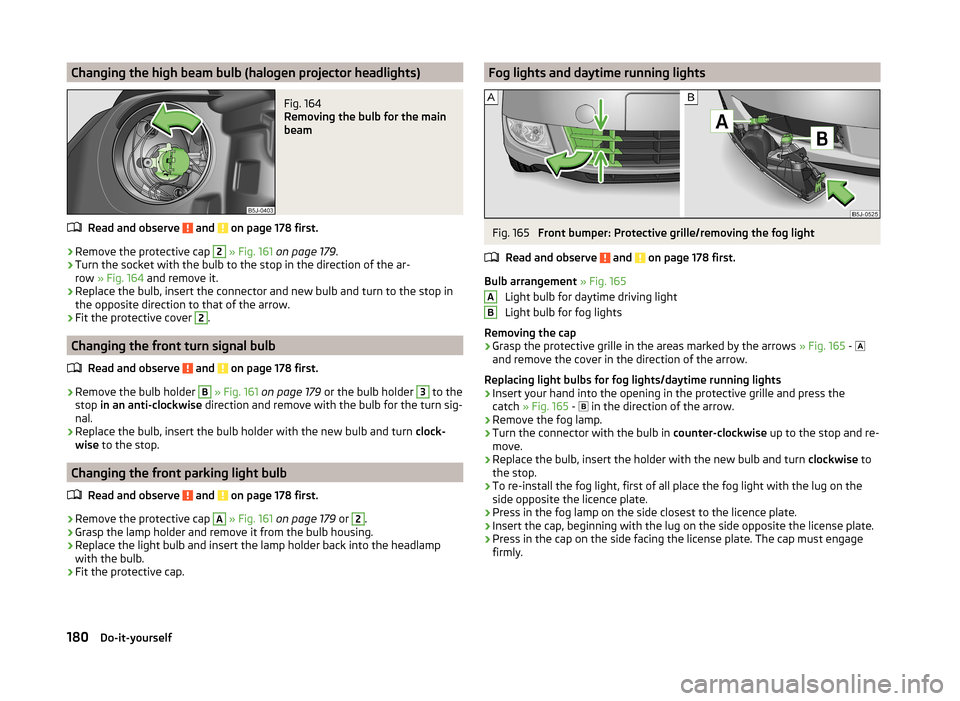
Changing the high beam bulb (halogen projector headlights)Fig. 164
Removing the bulb for the main
beam
Read and observe and on page 178 first.
›
Remove the protective cap
2
» Fig. 161 on page 179 .
›
Turn the socket with the bulb to the stop in the direction of the ar-
row » Fig. 164 and remove it.
›
Replace the bulb, insert the connector and new bulb and turn to the stop in
the opposite direction to that of the arrow.
›
Fit the protective cover
2
.
Changing the front turn signal bulb
Read and observe
and on page 178 first.
›
Remove the bulb holder
B
» Fig. 161 on page 179 or the bulb holder
3
to the
stop in an anti-clockwise direction and remove with the bulb for the turn sig-
nal.
›
Replace the bulb, insert the bulb holder with the new bulb and turn clock-
wise to the stop.
Changing the front parking light bulb
Read and observe
and on page 178 first.
›
Remove the protective cap
A
» Fig. 161 on page 179 or
2
.
›
Grasp the lamp holder and remove it from the bulb housing.
›
Replace the light bulb and insert the lamp holder back into the headlamp
with the bulb.
›
Fit the protective cap.
Fog lights and daytime running lightsFig. 165
Front bumper: Protective grille/removing the fog light
Read and observe
and on page 178 first.
Bulb arrangement » Fig. 165
Light bulb for daytime driving light
Light bulb for fog lights
Removing the cap
›
Grasp the protective grille in the areas marked by the arrows » Fig. 165 -
and remove the cover in the direction of the arrow.
Replacing light bulbs for fog lights/daytime running lights
›
Insert your hand into the opening in the protective grille and press the
catch » Fig. 165 -
in the direction of the arrow.
›
Remove the fog lamp.
›
Turn the connector with the bulb in
counter-clockwise up to the stop and re-
move.
›
Replace the bulb, insert the holder with the new bulb and turn clockwise to
the stop.
›
To re-install the fog light, first of all place the fog light with the lug on the
side opposite the licence plate.
›
Press in the fog lamp on the side closest to the licence plate.
›
Insert the cap, beginning with the lug on the side opposite the license plate.
›
Press in the cap on the side facing the license plate. The cap must engage
firmly.
AB180Do-it-yourself
Page 184 of 204
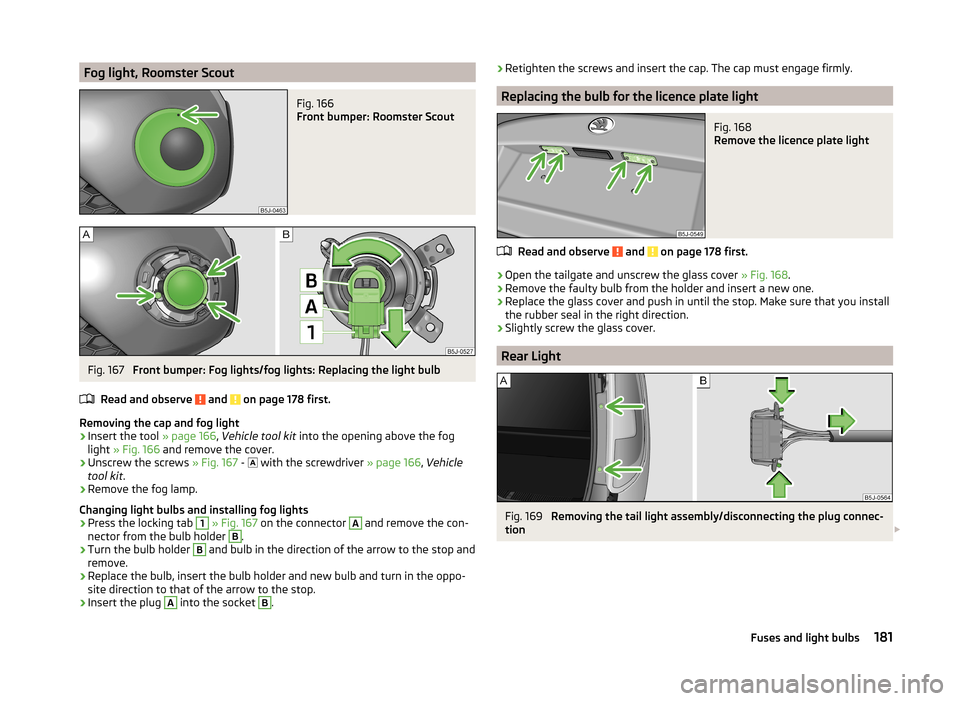
Fog light, Roomster ScoutFig. 166
Front bumper: Roomster Scout
Fig. 167
Front bumper: Fog lights/fog lights: Replacing the light bulb
Read and observe
and on page 178 first.
Removing the cap and fog light
›
Insert the tool » page 166, Vehicle tool kit into the opening above the fog
light » Fig. 166 and remove the cover.
›
Unscrew the screws » Fig. 167 -
with the screwdriver
» page 166, Vehicle
tool kit .
›
Remove the fog lamp.
Changing light bulbs and installing fog lights
›
Press the locking tab
1
» Fig. 167 on the connector
A
and remove the con-
nector from the bulb holder
B
.
›
Turn the bulb holder
B
and bulb in the direction of the arrow to the stop and
remove.
›
Replace the bulb, insert the bulb holder and new bulb and turn in the oppo-
site direction to that of the arrow to the stop.
›
Insert the plug
A
into the socket
B
.
› Retighten the screws and insert the cap. The cap must engage firmly.
Replacing the bulb for the licence plate light
Fig. 168
Remove the licence plate light
Read and observe and on page 178 first.
›
Open the tailgate and unscrew the glass cover
» Fig. 168.
›
Remove the faulty bulb from the holder and insert a new one.
›
Replace the glass cover and push in until the stop. Make sure that you install
the rubber seal in the right direction.
›
Slightly screw the glass cover.
Rear Light
Fig. 169
Removing the tail light assembly/disconnecting the plug connec-
tion
181Fuses and light bulbs
Page 185 of 204
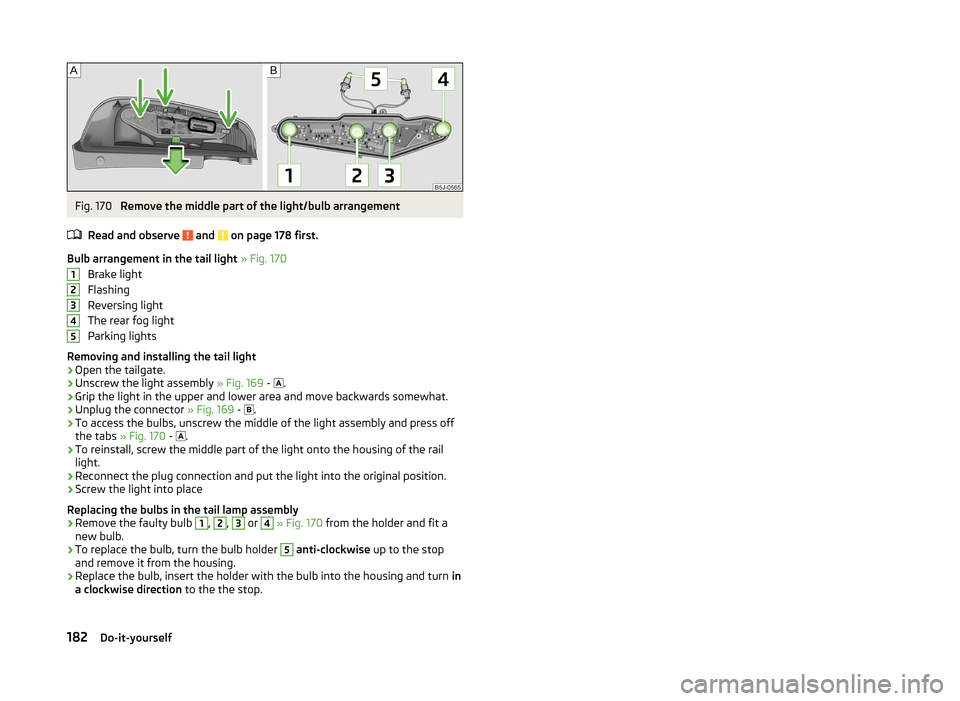
Fig. 170
Remove the middle part of the light/bulb arrangement
Read and observe
and on page 178 first.
Bulb arrangement in the tail light » Fig. 170
Brake light
Flashing
Reversing light
The rear fog light
Parking lights
Removing and installing the tail light
›
Open the tailgate.
›
Unscrew the light assembly » Fig. 169 -
.
›
Grip the light in the upper and lower area and move backwards somewhat.
›
Unplug the connector
» Fig. 169 -
.
›
To access the bulbs, unscrew the middle of the light assembly and press off
the tabs » Fig. 170 -
.
›
To reinstall, screw the middle part of the light onto the housing of the rail
light.
›
Reconnect the plug connection and put the light into the original position.
›
Screw the light into place
Replacing the bulbs in the tail lamp assembly
›
Remove the faulty bulb
1
,
2
,
3
or
4
» Fig. 170 from the holder and fit a
new bulb.
›
To replace the bulb, turn the bulb holder
5
anti-clockwise up to the stop
and remove it from the housing.
›
Replace the bulb, insert the holder with the bulb into the housing and turn in
a clockwise direction to the the stop.
12345182Do-it-yourself
Page 186 of 204
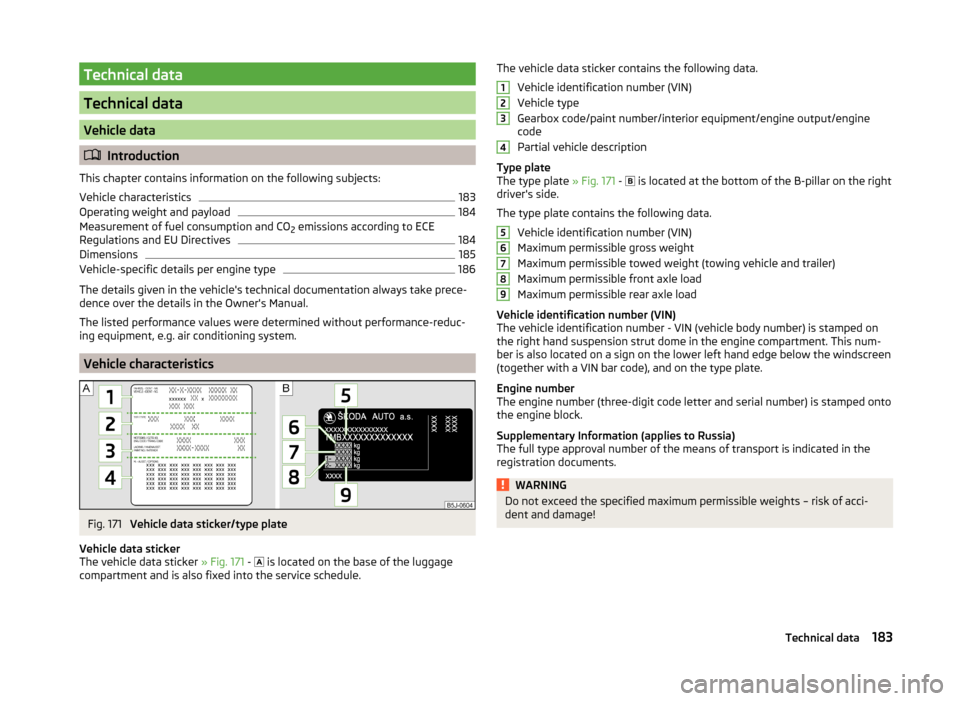
Technical data
Technical data
Vehicle data
Introduction
This chapter contains information on the following subjects:
Vehicle characteristics
183
Operating weight and payload
184
Measurement of fuel consumption and CO 2 emissions according to ECE
Regulations and EU Directives
184
Dimensions
185
Vehicle-specific details per engine type
186
The details given in the vehicle's technical documentation always take prece-
dence over the details in the Owner's Manual.
The listed performance values were determined without performance-reduc- ing equipment, e.g. air conditioning system.
Vehicle characteristics
Fig. 171
Vehicle data sticker/type plate
Vehicle data sticker
The vehicle data sticker » Fig. 171 -
is located on the base of the luggage
compartment and is also fixed into the service schedule.
The vehicle data sticker contains the following data.
Vehicle identification number (VIN)
Vehicle type
Gearbox code/paint number/interior equipment/engine output/engine
code
Partial vehicle description
Type plate
The type plate » Fig. 171 -
is located at the bottom of the B-pillar on the right
driver's side.
The type plate contains the following data. Vehicle identification number (VIN)
Maximum permissible gross weight
Maximum permissible towed weight (towing vehicle and trailer)
Maximum permissible front axle load
Maximum permissible rear axle load
Vehicle identification number (VIN)
The vehicle identification number - VIN (vehicle body number) is stamped on
the right hand suspension strut dome in the engine compartment. This num-
ber is also located on a sign on the lower left hand edge below the windscreen
(together with a VIN bar code), and on the type plate.
Engine number
The engine number (three-digit code letter and serial number) is stamped onto
the engine block.
Supplementary Information (applies to Russia)
The full type approval number of the means of transport is indicated in the
registration documents.WARNINGDo not exceed the specified maximum permissible weights – risk of acci-
dent and damage!123456789183Technical data
Page 187 of 204
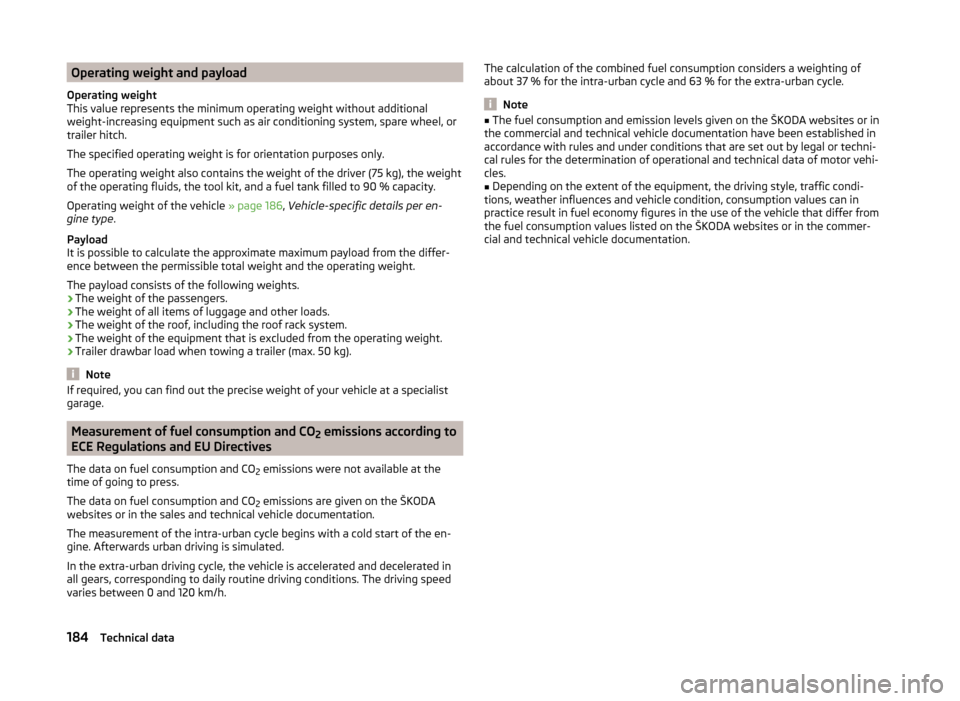
Operating weight and payload
Operating weight
This value represents the minimum operating weight without additional
weight-increasing equipment such as air conditioning system, spare wheel, or
trailer hitch.
The specified operating weight is for orientation purposes only.
The operating weight also contains the weight of the driver (75 kg), the weight
of the operating fluids, the tool kit, and a fuel tank filled to 90 % capacity.
Operating weight of the vehicle » page 186, Vehicle-specific details per en-
gine type .
Payload
It is possible to calculate the approximate maximum payload from the differ-
ence between the permissible total weight and the operating weight.
The payload consists of the following weights.
› The weight of the passengers.
› The weight of all items of luggage and other loads.
› The weight of the roof, including the roof rack system.
› The weight of the equipment that is excluded from the operating weight.
› Trailer drawbar load when towing a trailer (max. 50 kg).
Note
If required, you can find out the precise weight of your vehicle at a specialist
garage.
Measurement of fuel consumption and CO 2 emissions according to
ECE Regulations and EU Directives
The data on fuel consumption and CO 2 emissions were not available at the
time of going to press.
The data on fuel consumption and CO 2 emissions are given on the ŠKODA
websites or in the sales and technical vehicle documentation.
The measurement of the intra-urban cycle begins with a cold start of the en-
gine. Afterwards urban driving is simulated.
In the extra-urban driving cycle, the vehicle is accelerated and decelerated in
all gears, corresponding to daily routine driving conditions. The driving speed
varies between 0 and 120 km/h.
The calculation of the combined fuel consumption considers a weighting of
about 37 % for the intra-urban cycle and 63 % for the extra-urban cycle.
Note
■ The fuel consumption and emission levels given on the ŠKODA websites or in
the commercial and technical vehicle documentation have been established in
accordance with rules and under conditions that are set out by legal or techni-
cal rules for the determination of operational and technical data of motor vehi-
cles.■
Depending on the extent of the equipment, the driving style, traffic condi-
tions, weather influences and vehicle condition, consumption values can in
practice result in fuel economy figures in the use of the vehicle that differ from
the fuel consumption values listed on the ŠKODA websites or in the commer-
cial and technical vehicle documentation.
184Technical data
Page 188 of 204
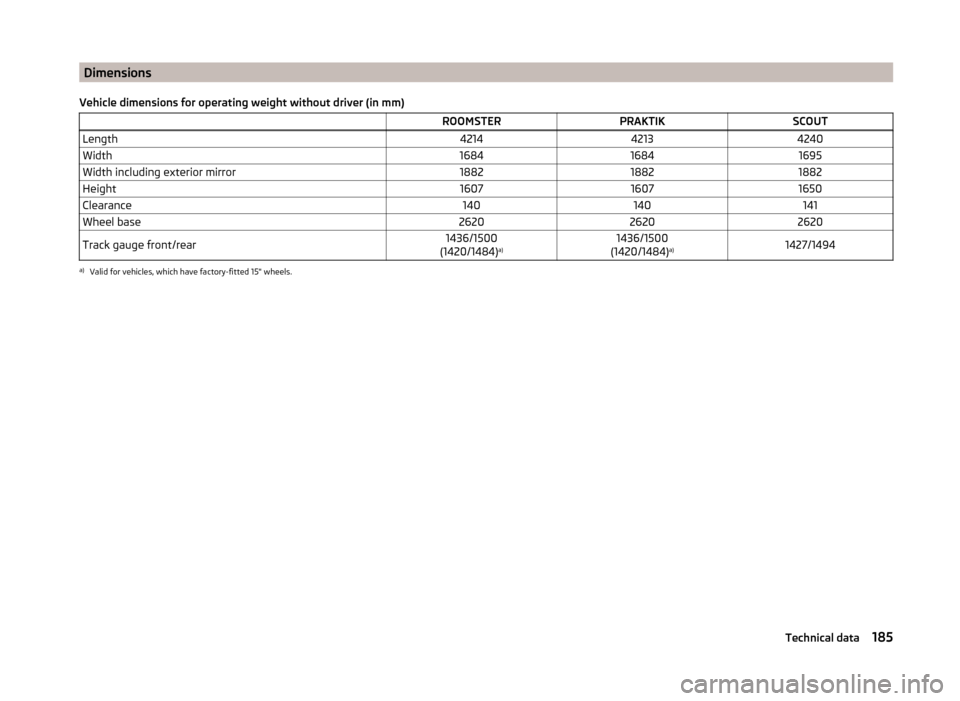
Dimensions
Vehicle dimensions for operating weight without driver (in mm) ROOMSTERPRAKTIKSCOUTLength421442134240Width168416841695Width including exterior mirror188218821882Height160716071650Clearance140140141Wheel base262026202620Track gauge front/rear1436/1500
(1420/1484) a)1436/1500
(1420/1484) a)1427/1494a)
Valid for vehicles, which have factory-fitted 15" wheels.
185Technical data
Page 189 of 204
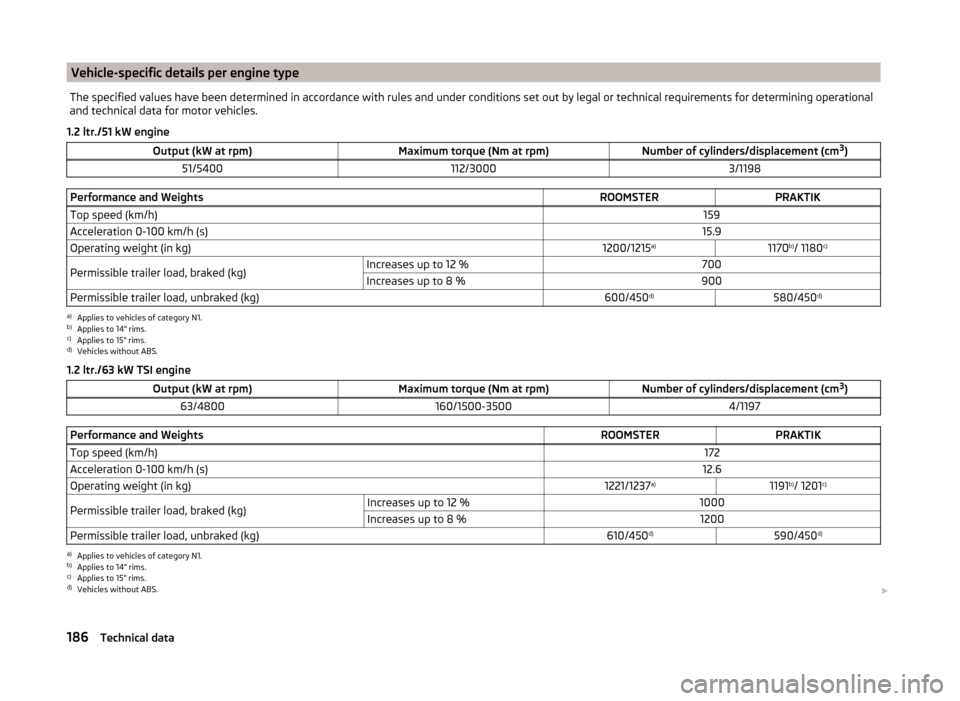
Vehicle-specific details per engine typeThe specified values have been determined in accordance with rules and under conditions set out by legal or technical requirements for determining operational
and technical data for motor vehicles.
1.2 ltr./51 kW engine
Output (kW at rpm)Maximum torque (Nm at rpm)Number of cylinders/displacement (cm 3
)51/5400112/30003/1198Performance and WeightsROOMSTERPRAKTIKTop speed (km/h)159Acceleration 0-100 km/h (s)15.9Operating weight (in kg)1200/1215 a)1170b)
/ 1180 c)Permissible trailer load, braked (kg)Increases up to 12 %700Increases up to 8 %900Permissible trailer load, unbraked (kg)600/450 d)580/450d)a)
Applies to vehicles of category N1.
b)
Applies to 14" rims.
c)
Applies to 15" rims.
d)
Vehicles without ABS.
1.2 ltr./63 kW TSI engine
Output (kW at rpm)Maximum torque (Nm at rpm)Number of cylinders/displacement (cm 3
)63/4800160/1500-35004/1197Performance and WeightsROOMSTERPRAKTIKTop speed (km/h)172Acceleration 0-100 km/h (s)12.6Operating weight (in kg)1221/1237 a)1191b)
/ 1201 c)Permissible trailer load, braked (kg)Increases up to 12 %1000Increases up to 8 %1200Permissible trailer load, unbraked (kg)610/450 d)590/450 d)a)
Applies to vehicles of category N1.
b)
Applies to 14" rims.
c)
Applies to 15" rims.
d)
Vehicles without ABS.
186Technical data
Page 190 of 204
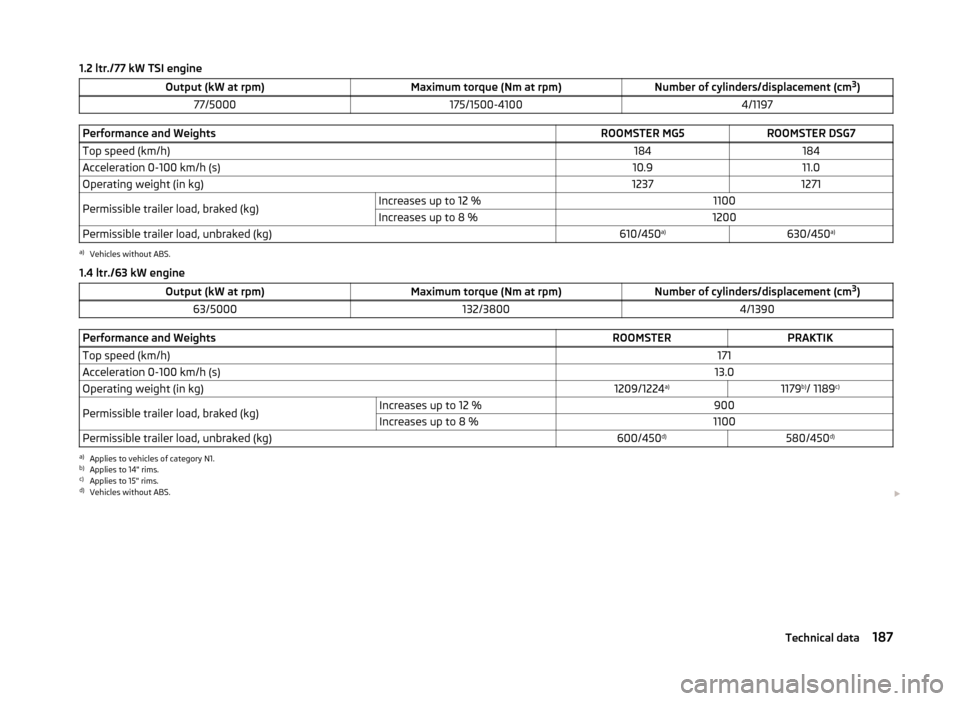
1.2 ltr./77 kW TSI engineOutput (kW at rpm)Maximum torque (Nm at rpm)Number of cylinders/displacement (cm3
)77/5000175/1500-41004/1197Performance and WeightsROOMSTER MG5ROOMSTER DSG7Top speed (km/h)184184Acceleration 0-100 km/h (s)10.911.0Operating weight (in kg)12371271Permissible trailer load, braked (kg)Increases up to 12 %1100Increases up to 8 %1200Permissible trailer load, unbraked (kg)610/450 a)630/450 a)a)
Vehicles without ABS.
1.4 ltr./63 kW engine
Output (kW at rpm)Maximum torque (Nm at rpm)Number of cylinders/displacement (cm 3
)63/5000132/38004/1390Performance and WeightsROOMSTERPRAKTIKTop speed (km/h)171Acceleration 0-100 km/h (s)13.0Operating weight (in kg)1209/1224 a)1179b)
/ 1189 c)Permissible trailer load, braked (kg)Increases up to 12 %900Increases up to 8 %1100Permissible trailer load, unbraked (kg)600/450 d)580/450d)a)
Applies to vehicles of category N1.
b)
Applies to 14" rims.
c)
Applies to 15" rims.
d)
Vehicles without ABS.
187Technical data